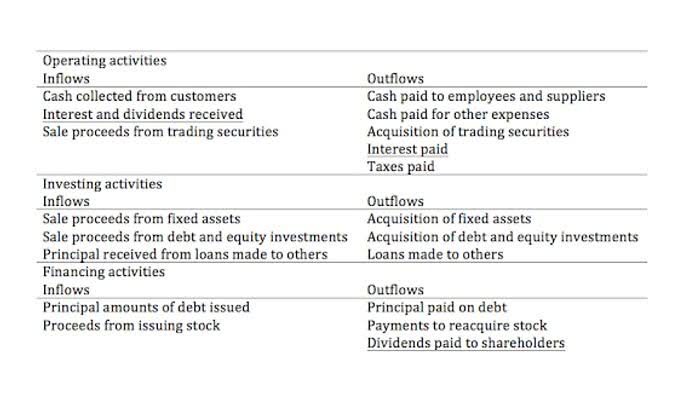Chưa có sản phẩm trong giỏ hàng.
Bookkeeping
Understanding the Difference Between FOB Shipping Point and FOB Destination

This is where FOB shipping terms come in as an essential compass for businesses engaging in international trade. With the expansion of international trade, businesses around the world face the challenges of shipping products vast distances across borders. FOB stands for either “free on board” or “freight on board.” The term is used to designate ownership between the buyer and the seller as goods are transported. When it comes to the FOB shipping point option, the seller assumes the transport costs and fees until the goods reach the port of origin. In this case, the seller completes the sale in its records once the goods arrive at the receiving dock. In general, the accounting entries are often performed earlier for an FOB shipping point transaction than an FOB destination transaction.
- FOB in export refers to a standard set of rules in international trade process that is carried out by two parties from two distinct locations.
- With a CIF agreement, the seller has more responsibility, paying for the transport costs and insurance, influencing cost distribution and risk allocation.
- FOB destination point refers to a product sold to a customer after it arrives at the buyer’s destination.
- The opposite is FOB Destination, where the seller remains responsible for goods until they reach the buyer’s destination.
- In FOB Destination transactions, the sale takes place when the receiving dock accepts the goods even if the buyer won’t pay for the shipment for another 30 days.
- The buyer’s influence extends to logistics decisions, and freight charges, allowing for strategic choices in transportation methods and ensuring alignment with their specific requirements and preferences.
Tips for Reducing Freight Costs with FOB Shipping Point and FOB Destination
Properly applying FOB terms ensures accurate reporting of sales revenue and inventory values. Accurate financial reporting is essential under various FOB terms to reflect the true financial position of a company. Misinterpretation or misapplication of these terms can lead to incorrect revenue recognition or inventory valuation, affecting profitability. Financial considerations for buyers include managing additional costs beyond the product price, impacting overall procurement budgets.
A common mistake is using FOB Incoterms® for containerised cargo

One of the most prominent examples of this standardization is the International Commercial Term, or incoterm. The phrase passing the ship’s rail is no longer in use, having been dropped from the FOB Incoterm in the 2010 revision. An alternative could be other Incoterms like CIF, EXW, or DAP, depending on the desired distribution of responsibilities. In this guide, we’ll explain everything you need to know about FOB shipping point. Double Entry Bookkeeping is here to provide you with free online information to help you learn and understand bookkeeping and introductory accounting.
Understanding Incoterms in International Shipping
With FOB destination, ownership of goods is transferred to the buyer at the buyer’s loading dock. The qualifiers of FOB shipping point and destination are sometimes used to reduce or extend the responsibility of the supplier in an FOB shipping agreement. FOB status signifies the point in international shipping where ownership and responsibility for goods transfer from the seller to the buyer. The buyer pays for the freight cost in the FOB shipping point agreement from the designated shipping point onwards. So, let’s delve into these sea shipping Incoterms to gain an understanding of their roles in facilitating global trade.
Freight Prepaid and Added
Shipping via FOB Incoterms from China is simple, straightforward, and the ideal way to ensure your products leave China safely and arrive at your destination seamlessly. Once you have all of this information from your supplier, you can request a quotation from us, and we will send you a detailed shipping offer for your cargo. To harness the advantages of FOB, one must engage in meticulous negotiation and take into account the distinct needs and preferences of both parties participating in the global trade transaction. This division of duties traces each party’s distinct responsibilities in facilitating the seamless movement of goods from the seller’s warehouse to the buyer. FOB is a point is the agreed delivery spot between both buyer and seller for handover of goods where the peril of goods is moved from the seller to the buyer. In short, all FOB charges from point of origin till the goods are loaded at the port.
Risks and Disadvantages of FOB Destination
- The International Chamber of Commerce (ICC) publishes 11 Incoterms (international commercial terms) that outline the roles of both sellers and purchasers in global shipments.
- Yet, as a part of discipline it can be agreed upon as a seller’s matter of concern till the port.
- In this situation, the billing staff must be aware of the new delivery terms, so that it does not bill freight to the customer.
- For FOB Origin, the buyer assumes all risks related to damage, destruction, and loss during transit once the goods are loaded onto the chosen mode of transport at the origin point.
- In this circumstance, the billing staff must be notified of the changed delivery conditions so they do not charge freight to the consumer.
Only when the purchase arrives in perfect condition does the buyer accept it and consider the sale officially complete. When goods are labeled with a destination port, the seller stays responsible for damages, lost items, and other costs and issues until the shipment is complete. If you use accrual accounting and the buyer doesn’t pay, you have to report this in your accounts receivable. Say the buyer defaulted on a $3,000 toy shipment after you entered it in your ledgers.
Freight Collect is often the choice for businesses that prefer to have full control over every aspect of the shipping process, from selecting shipping terms to managing freight charges. However, this method does place the onus of risk and responsibility firmly on the buyer’s shoulders, from the point of FOB designation to the goods’ arrival at the buyer’s location. The buyer assumes all risks and benefits of ownership as of the moment the shipment https://www.bookstime.com/ arrives at the shipping dock. Also, under FOB destination conditions, the seller is liable for the merchandise’s transportation costs. Buyers can calculate the total costs of a FOB agreement by combining the FOB price from the seller and requesting a quotation from their freight forwarding company for the logistics. The seamless movement of goods across international boundaries is crucial for businesses involved in global commerce.
FOB in accounting terms determines when the buyer and seller record the sale in their ledgers. FOB in global trade does not inherently include insurance coverage for the goods transported. While FOB outlines the transfer of ownership and responsibility, it is crucial to note that insurance fob point meaning is not automatically provided. Specifying insurance paid separately on freight invoice is essential to safeguard against potential risks, damages, or losses when transporting goods. FOB value for both buyer and seller can be calculated as per these costs incurred by them as per FOB rules.


